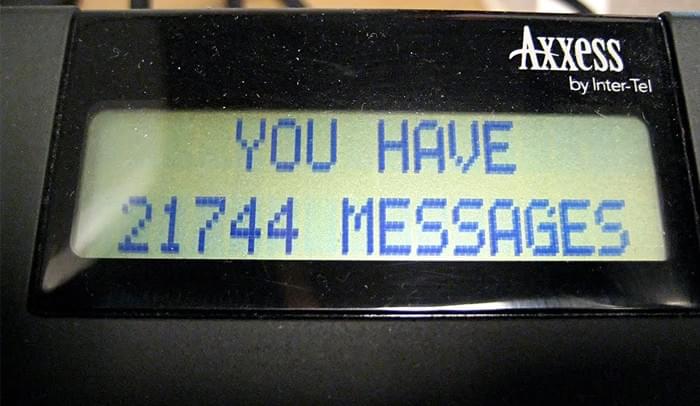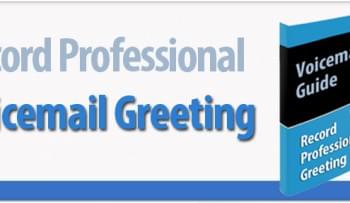We all want to be interesting — but sometimes there’s a lot more at stake.
Today, we have all sorts of technology to help us set up versatile and convenient voicemail systems. The human side of voicemail works on creativity, philosophy and intellectual decision-making. For example, there’s the idea of figuring out how to keep callers on the line long enough to get them to leave a message. Too many callers hang up before the beep. They don’t wait to leave a voicemail message the way they used to. Why is this happening?
Here are some recommendations from professionals who have worked on this intriguing question, along with some cautionary tales about how boring and generic messages can turn callers off. Take a look at this list to see how you can add vitality to your desktop by recording a business voicemail greeting that will work harder for you when you’re not around to pick up the phone.
Inject a Little Humor
Rich DiGirolamo says he has stumbled on the “secret sauce” of an attractive voicemail, and it involves injecting a little humanity and humor into something that’s too often prosaic and impersonal. DiGirolamo’s business, RECESSitator, brings a fresh look to the business world, and DiGirolamo himself does speaking events and more. So what’s on DiGirolamo’s voicemail?
Here’s a paraphrase:
“If you called to make some plans, have some fun, or just laugh a little bit, absolutely leave a message. If you have called to whine, complain or get into a shouting match, I’m sure there is someone else in your network who would love to hear from you! Make it a great day!”
Listening to this message is infectious. It’s not hard to see how breaking the mold and making a message your own can keep people listening, not bored, but attentive.
Provide Callers with the Timeframe of When You Check Your Voicemails
Marilyn Suttle, President of Suttle Enterprises, is a customer experience consultant, and bestselling business author.
To get callers to leave a message, Suttle recommends using a phrase like this: “I check my messages frequently throughout the day.” People are more likely to invest time in leaving details on voicemail when they know that someone will actually be checking the voicemail at a specific time, and calling back. Otherwise, they may feel a little like they’re shouting into a void.
Offer Your Callers the Option to Text or Email You
“Want the best tip of all?” says John Monarch, CEO of Direct Outbound Services, in Greenville, South Carolina. “If your potential client is a millennial, don’t leave a voicemail. Text them.”
Many busy entrepreneurs, like Monarch, prefer texts over voicemail for a couple of reasons. First, it saves time (unless your message is so long that tapping it out on a touch screen is not viable) – Secondly, as Monarch points out, younger audience often have a built-in “text preference” that makes them much more comfortable interacting via text than over a voice line.
“I own a call center,” says Monarch, “and while I love VoIP, I never check my voicemail. I’m 28 and it’s a distraction.”
Use a Few Words Rather than Many – Brevity is a Good Tool
John Kinskey at AccessDirect, Inc. has been providing voicemail services, including professional recordings, for 17 years.
Kinskey has a very simple, but in his view, fundamental tip: keep it short. Part of the issue, says Kinskey, stems from generational changes in the way we communicate.
“From when I started my voice mail business 17 years ago to now, voicemail etiquette has changed dramatically.” Kinskey says. “It used to be that an official greeting, and stating the obvious: ‘I am away from the phone or in a meeting’…was polite. Now, it just takes too long to listen to a voicemail greeting when one can hang up and text or email.”
Kinskey says it’s essential to just give basic information and get out of the way so callers can “get to the beep.”
“Long drawn out voice mail greetings in today’s fast response world may cause a caller to hang up.” Kinskey says. Also, Kinskey suggests allowing a bypass system, where callers can use hot keys such as the pound sign to get around the voice mail message entirely on return calls.
Be Polite and Use the Words “Please” and “Thank You” – Set an Inviting Tone
A little politeness can sometimes go a long way. Talking about the finer points of voicemail etiquette, and how to convert callers, Andy LaPointe at Traverse Bay Farms says those creating a voicemail will benefit from making good use of “please” and “thank you.”
LaPointe says in his experience, people also respond better to a female voice, one that is not rushed, but that speaks at a good pace.
Balance the Need for Uniqueness with the Need for Professionalism
Amy Grey works in HR at Teamwork Retail, a company that provides a completely mobile, cloud based retail technology to turn retail establishments into iPad based mobile POS systems.
Grey says it’s important to strike a balance between being too cold or impersonal, or making a message too bohemian or strange.
“Maybe you include something that makes them laugh or at least creates a lasting memory.” Grey says. “A voicemail that is memorable will engage a client and show that you care about the small details.”
Cultivate a Positive Impact by Smiling on the Phone
We heard this one from multiple sources, from lists of web tips on workplace etiquette, and behavioral pros, but it’s also another tip Amy Grey included in her list of voicemail turn-ons, and it’s a good one: smile.
“It sounds strange to smile while you are on the phone,” Grey says, “Because obviously the person on the other line will not be able to see it, but trust me, it makes a difference in the way you talk. Smiling while you talk will change the way your voice sounds.”
Turn Off the Background Noise
Grey also includes another great tip on “voicemail turn-offs:”
“You should be in a quiet room while recording the message with no background noise at all.” Grey says.
Background noise has a definite effect on a caller. In some cases, it might make sense, but usually, it just disorients and confuses someone who wants to hear your response message, so before recording, do your callers a favor and silence the machines and everything else that can intrude into the caller’s ear.
Give as Good as You Get
Ben Landers is president of Blue Corona, an online marketing and analytics company that helps business owners accurately track the results of their advertising initiatives and generate more leads and sales from the web.
Landers has a tip for when the shoe is on the other foot, and you’re not the one recording the voicemail response, but the one calling in. “I get a million calls a day,” Landers says, “Many of which are solicitations. As someone with a background in sales and marketing, I actually don’t mind being solicited. What I absolutely can’t stand are long-winded, rambling voice mails where the caller waits to leave their callback number until the very end of their message! These same people also tend to say their number once and very quickly.”
Instead, Landers suggests, be clear and succinct. “Say your name, your number, and where you’re calling from.” Landers says. “Give me your pitch–be brief and be bold. Then say your name again and your number–twice.” Sales people, he says, can take this strategy to heart, and make their outbound cold calls go a lot better.
Use New Technology
Alex Quilici works at YouMail.com, a company he says has the largest 3rd party automated call answering service in the world, approaching 7 million registered users, and has ‘automatically answered’ over 4 billion calls. So what’s great about the voicemails that garner the most engagement and interest at YouMail?
Quilici says it’s as easy as using someone’s name.
As we mentioned in our story on IVR’s, the technology exists to personalize voice calls. It’s remarkably easy for a database hooked up to a natural language technology to generate a call, or a callback message, that calls someone by name. Quilici says the service that automatically greets callers by name gets “huge positive feedback” from users.
Integrate all of these tips into your playbook to create voice mail responses that will do wonders for your professional career – and make callers like you a lot more.
More Tips:








